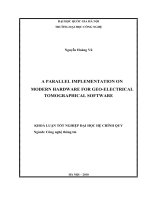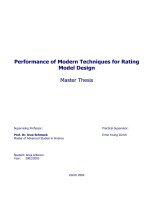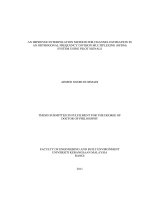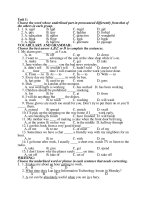Modern method for guitar 1
Bạn đang xem bản rút gọn của tài liệu. Xem và tải ngay bản đầy đủ của tài liệu tại đây (5.42 MB, 127 trang )
This book has been specifically designed to accomplish two things...
#1. To teach the student to READ music.
Reading "crutches" have been eliminated as much as possible.
Fingering and counting indications have been kept at what I con-
sider a sensible minimum.
#2. For the gradual development of dexterity in BOTH hands.
This is the physical part of learning to play the guitar and as
such cannot be rushed. Practice all material slowly enough
to maintain an even tempo. Do not skip or "slight" anything,
and also do not attempt to "completely perfect" any one lesson
before going on. Playing technique is an accumulative process
and you will find each time you review material already studied
it will seem easier to play. (Slow, steady practice and constant
review will eventually lead to speed and accuracy.)
I should like to mention at this point that all music presented for study on
these pages is original and has been created especially for the guitar. EACH
composition has been designed to advance the student's musical knowledge
and playing ability, and yet be as musical as possible. There is no student-
teacher division in the duets. Both guitar parts are written to be studied
by the pupil and almost all parts will musically stand alone.
I have not included any "old favorites" as guitar arrangements of these songs
are available in many existing publications. (Also, you do not learn to READ
music by playing melodies that are familiar to you.)
I have not tried to make this book into a music dictionary by cramming it with
pages filled with nothing but musical terms and markings as it is consider-
ably more important to give the student as much music to play as possible.
(The most common and necessary terms and markings are, of course, used
and explained... If further information is desired, some very excellent music
dictionaries in soft cover editions can be obtained at a small cost.)
I do feel, however, that with this method, (as with all others) you must search
out additional material to practice as your ultimate ability depends entirely
on how much reading and playing you do.
So good luck, and have fun. ...
y)
Continued on next page
TIME SIGNATURES: Next to the clef sign (at the beginning of a composition) are
found two numbers (like a fraction) or a symbol which re-
presents these numbers. The top number tells how many
beats (or counts) in a measure, and the bottom number
indicates what kind of note gets one beat.
"READ" the notes, NOT the fingering, as these
numbers will eventually be omitted. . . .
. . . . . . . . . Starting on C one OCTAVE higher than C found on the
5th string, we complete the UPPER REGISTER of the 1st position
Note And Chord Review
(Regular review of all material is a must!)
"LEDGER" lines are added below or above the staff for
notes too low or too high to appear on the staff. . . . . .
Rhythm Accompaniment
BASS NOTES AND CHORDS
All chord symbols (names) appearing as only a letter are assumed
to be MAJORchords. A letter followed by the numeral "7" represents
DOMINANT 7th chords. A letter followed by a small "m" are MINOR
(Do not skip or "slight" any lesson material)
(Review of all material is a must)
( EIGHTH NOTES. . . counting and picking )









